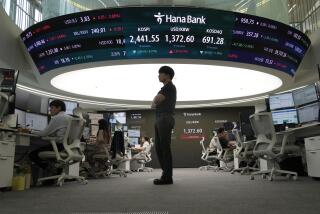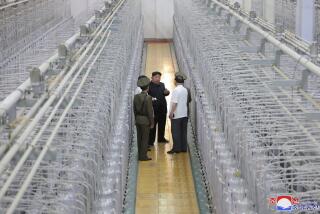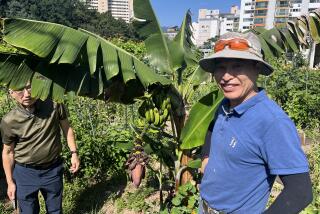A North Korean farm may not be what it appears
- Share via
Reporting from Pyongyang, North Korea — It looked like a farm: Cabbages were growing in neat rows in the dirt. Cucumber vines stretched to the ceiling in a spotless greenhouse, with an orange tractor parked out front. And it smelled, faintly, like a farm.
But in North Korea, master of the Potemkin everything, what looks like a duck and quacks like a duck can sometimes turn out to be a chicken. Or maybe even a frog.
Jangchon vegetable commune was stop No. 1 on Wednesday’s heavily controlled tour for dozens of foreign journalists now visiting the country. If the government propaganda workers are to be believed, Jangchon is a shining beacon of new, improved, more eco-friendly agricultural systems that will help this notoriously food-challenged country of 24 million into a new era of not only self-sufficiency but abundant harvests.
“Other farms are trying to be like this,” said Jo Yong Pyo, the ruddy-faced 62-year-old chief engineer, guiding a few dozen overseas reporters around the facility in his galoshes.
INSIDE NORTH KOREA: Full coverage
He and other administrators of the facility, which was remodeled into a “farm of the future” last year at the behest of leader Kim Jong Un, proudly pointed out its many features including solar power panels on workers’ homes, a community clinic, a nursery school, and hundreds of greenhouses for growing food year-round. There was even a hothouse devoted to cultivating snails.
(Watch a video produced by the North Korean government here.)
A giant mosaic of founding father Kim Il Sung, dressed in a gray suit and tie, gazing out blissfully amid a field of green cabbages, was the focal point of the complex’s main parking lot.
“Our grand marshal Kim Jong Un visited here last June 29 and said it was as beautiful as a picture,” gushed a guide, Park Myong Shil. Kim also visited the farm in 2014, and propaganda signs on the newly built greenhouses call out to workers: “Let’s thoroughly accomplish the words spoken by dear leader Kim Jong Un on his visit of June 9, 2014!”
RELATED: North Korean capital in throes of ‘70-Day Speed Battle’ to prepare for political confab
But oddly, there seemed to be few farm workers on the job during the media tour, prompting one photographer to ask a guide: “Can you find me some farmers doing something that I can take a picture of?” Exactly who was tending to all these robust plots of chives, lettuce and cabbage was a mystery. As was how they managed to keep a supposedly working farm so clean as to seem almost sterile.
Ahead of Friday’s 7th Workers’ Party Congress, a high-level gathering of the ruling party, Kim Jong Un is trying to demonstrate to the world – and his own people – that he’s building a more prosperous, and more powerful, country.
North Korea suffered a severe famine in the 1990s, with hundreds of thousands believed to have starved to death and huge swaths of the population forced to resort to eating bark and leaves to survive. Shortly after coming to power in December 2011, Kim vowed an end to hunger in the country.
And in the last few years, food production has been rising, outside experts say. But North Korea experienced a severe drought last year, and the U.N. Food and Agriculture Organization estimated in April that the country’s total food production – including cereals, soybeans and potatoes – declined in 2015, the first drop since 2010.
Last year, North Korea’s total food production is estimated to have been about 5.4 million tons, down 9% from to 5.9 million in 2014. Production of paddy rice, the country’s main staple, fell by 26% to 1.9 million tons, FAO said, mainly due to poor rains and low availability of water for irrigation.
“We lost 500 kilograms of production per hectare,” or about 440 pounds per acre, said Ri Sung Il, deputy director of the Jangchon farm.
The agency estimated North Korea would need to import 694,000 tons of grains between November 2015 and this October. With the government expected to import 300,000 tons, that leaves an expected deficit of 394,000 tons, the biggest gap in four years.
“Due to the natural disasters, we can’t grow enough. Last year we were hit by a severe drought, and it was the worst in several years,” conceded Jo, the commune engineer. But striking an optimistic tone, he added: “But from this year, we are trying to produce more crops. Maybe we will not feel the food shortages this year.”
The natural – and political – environment remains uncertain, however. A recent editorial in the state-run Rodong Sinmun newspaper in March, following the imposition of new U.N. sanctions in the wake of North Korea’s January nuclear test, warned that “the road to revolution is long and arduous. We may have to go on an arduous march, during which we will have to chew the roots of plants once again.”
While Jangchon may embody North Korea’s agricultural ambitions, the fields alongside the road to the model commune reflected a more humble reality: small clutches of workers with rudimentary tools, biking on dirt tracks to toil in messily plowed fields. There was not a tractor in sight, and just one ox to be spotted along the 20-minute drive.
RELATED: At a North Korean nursery school, tots get an early education in weaponry
Some modest agricultural reforms have been introduced to try to incentivize farmers to produce more. Farmers are now supposed to be able to keep 30% of the rice they grow, while giving 70% to the state, said Ri Seung Il, the farm director. They can keep 10% of the vegetables they grow as well, in addition to what’s planted in personal gardens around their homes.
Although North Korea has gradually embraced some markets as the state-run distribution system has failed to keep pace, rations are still an important source of food for citizens. Hwang Myong Sim, a government guide and interpreter, said last year rice rations were reduced amid the drought. “We got more maize instead,” she said.
In addition to rice, Hwang said her family of five typically receives eggs, soy sauce, oil, salt, bean paste, vegetables and sometimes potatoes as handouts from the state. The allotments come monthly and are based on household size, she said.
Hong Son Suk, a former primary school teacher in her 50s, was asked to open her home at Jangchon to foreign reporters to show them how well off she was.
A whitewashed one-story structure with a blue roof and a dog on the front stoop, it featured amenities including bamboo floors, two chest-style freezers, a washing machine, a stereo, a flat-screen TV and DVD player, telephone and an electric fan. As is required in all North Korean homes, portraits of Kim Il Sung and Kim Jong Il were hung on the wall.
“We are leading a happy life under the warm love of our leaders,” Hong said, government minders and interpreters watching over her interaction with the foreign reporters.
Jo, asked by one journalist whether people blamed the government for food shortages, reacted with a blank look. “This is not even a question for us, we cannot understand this question,” he said.
A guide quickly jumped in: “Our people don’t blame,” he said.
Follow @JulieMakLAT for news from China
ALSO
Tesla Motors posts a bigger loss, and two key executives plan to leave
LAPD hacked into iPhone of slain wife of ‘Shield’ actor, documents show
San Andreas fault ‘locked, loaded and ready to roll’ with big quake, expert says
More to Read
Sign up for Essential California
The most important California stories and recommendations in your inbox every morning.
You may occasionally receive promotional content from the Los Angeles Times.











